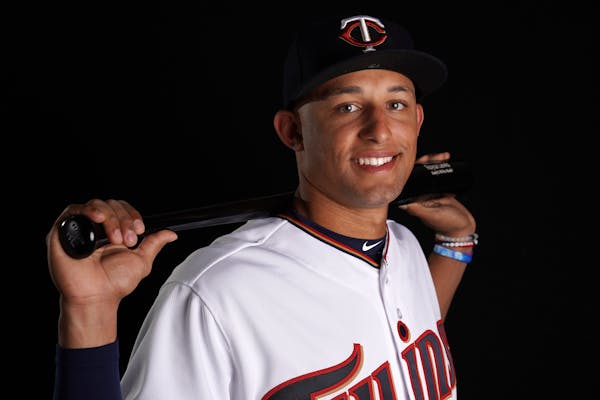CHICAGO – It was shortly before 1 p.m. in suburban Denver last Thursday when the craziness began. A time zone away, at Target Field, Twins manager Paul Molitor trudged to the mound and signaled for a lefthanded reliever. At the same moment 1,000 miles farther east, at a stadium in Manchester, N.H., a righthander jogged out of the bullpen to pitch the seventh inning for the Richmond Flying Squirrels, a Class AA team.
Suddenly, Scott and Amy Rogers' attention was divided and intensified, all at once, as they watched mirror images pitch. "They had games on two screens, and were watching both at once," said Taylor Rogers, the Twins lefthander and older brother — by 30 seconds — to Giants prospect Tyler Rogers, a Richmond righthander. "They were cracking up, because we were pitching at the exact same time."
Alas, the levity didn't last long. Perhaps identical twins pitching at identical times disrupts baseball karma, because neither Rogers was sharp. Taylor gave up two hits and an intentional walk to the Phillies, loading the bases before extricating himself from the jam by striking out former NL MVP Ryan Howard with a curveball. Tyler's outing against the Hartford Yard Goats was even worse: Two singles and a double scored the first runs he had given up all season, snapping his Richmond record 23⅔-inning scoreless streak.
The brothers probably should get this same-time conflict resolved, because each appears to have a major league career ahead of him.
"That's what we always dreamed of," Taylor Rogers said. "Being in the big leagues together."
Taylor made it first, but Tyler, who leads the Eastern League in appearances and owns a 0.77 ERA, isn't far behind. Their faces and body types may be identical, but their styles are completely different: The lefty comes over the top, mixing straight fastballs with a nasty curve. The righty pitches submarine-style, "all the way down there. He scrapes his knuckles," his brother said.
There used to be another big difference, too, but that one evaporated the moment Molitor realized how useful the 25-year-old Rogers can be. A starter his entire career — he has made 87 minor league starts in five professional seasons — Rogers was sent to the bullpen in the majors. While his brother is comfortable as a potential closer, Rogers is still figuring out the adjustment to pitching on short notice.
"There are a lot of little things. Like lifting [weights] — as a starter, you lift two days after you pitch, so that's easy," Rogers said. "As a reliever, you might be throwing that day, so I was a little worried about when to lift. … I don't look like I lift a lot, but it is important."
He has turned to bullpen coach Eddie Guardado, a longtime closer, for advice on plenty of those issues. And he asks his brother, too.
"We give each other tips. He told me stuff on how to stay ready, that sort of thing," Rogers said. "We talk most every day, or we try to. As you can imagine, it's a little different from a classic sibling relationship."
Taylor Rogers might be experiencing a classic route to a major league rotation, though. For decades, most rookies had to prove themselves in the bullpen before they got starting opportunities. Rogers said he wouldn't mind if that happens to him, too — though he's hardly complaining about his apprenticeship. One thing might keep him in the pen, however: his own effectiveness.
"It's taken him some time to adapt. He's done it very well, particularly as of late," Molitor said. "He has value for me right now. … He can get lefties and righties out."
So it seems. Taylor Rogers has struck out 20 batters in 22 innings and walked only four. He owns a 3.63 ERA in 20 Twins appearances, but that number was inflated by a disastrous night against the Angels earlier this month, when he faced nine batters, retired only two and gave up four runs. In his other 19 opportunities? That ERA is 2.08.
"I like what I'm seeing out of him. He's starting to throw with the velocity we thought we might see," General Manager Terry Ryan said of Rogers, whose fastball is in the range of 93-94 miles per hour. "It's been encouraging."
Encouraging enough to project him going back to a starting role? It might depend upon Rogers' changeup, which he is trying to improve upon, and gain confidence in, this season. Molitor, for one, is intrigued.
"If we have transition over time, whether it's a year or two years [away], however it might work out, I would keep him in mind as a guy who potentially might be very good as a starter," Molitor said. "If the changeup develops, that third pitch — there's a lot of really good starters with three pitches. Right now, with a two-pitch mix, it probably plays better in the bullpen. For now."
Joel Embiid scores 23 points, has the big assist as 76ers beat Heat in play-in to earn No. 7 seed
RBI singles by Anthony Rendon and Taylor Ward in the 9th inning lead Angels beat past Rays 5-4
Houck throws 3-hitter in 2-0 win over Guardians for Boston's 1st CG shutout at Fenway since 2017

